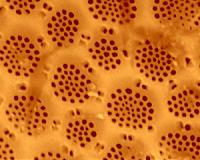 |
Washington DC (SPX) Jul 22, 2010 Scientists are reporting an in-depth validation of the discovery of the world's first mass producible, low-cost, organoclays for plastics. The powdered material, made from natural clay, would be a safer, more environmentally friendly replacement for the compound widely used to make plastics nanocomposites. Miriam Rafailovich and colleagues focused on a new organoclay developed and patented by a team of scientists headed by David Abecassis. The scientists explain that so-called quaternary amine-treated organoclays have been pioneering nanoparticles in the field of plastics nanotechnology. Just small amounts of the substances make plastics flame retardant, stronger, and more resistant to damage from ultraviolet light and chemicals. They also allow plastics to be mixed together into hybrid materials from plastics that otherwise would not exist. However, quaternary amine organoclays are difficult to produce because of the health and environmental risks associated with quaternary amines, as well as the need to manufacture them in small batches. These and other disadvantages, including high cost, limit use of the materials. The new organoclay uses resorcinol diphenyl phosphate (which is normally a flame retardant), to achieve mass producible organoclays which can be made in continuous processing. In addition these organoclays are cheaper, generate less dust, and are thermostable to much higher temperatures (beyond 600 degrees Fahrenheit). This clay has also been proven to be superior for flame retardance applications. In addition, unlike most quaternary amine based organoclays, it works well in styrene plastics, one of the most widely used kinds of plastic.
Share This Article With Planet Earth
Related Links American Chemical Society Space Technology News - Applications and Research
 Microbial World's Use Of Metals Mostly Unmapped
Microbial World's Use Of Metals Mostly UnmappedBerkeley CA (SPX) Jul 21, 2010 A new way of surveying microbes for the metals they contain reveals that biologists have been relying on the equivalent of a 15th century map of the world. It turns out that there are many more metal-containing proteins in microbes than previously recognized. This means the microbial world boasts a broader and more diverse array of metal-driven chemical processes than scientists have imagi ... read more |
|
| The content herein, unless otherwise known to be public domain, are Copyright 1995-2010 - SpaceDaily. AFP and UPI Wire Stories are copyright Agence France-Presse and United Press International. ESA Portal Reports are copyright European Space Agency. All NASA sourced material is public domain. Additional copyrights may apply in whole or part to other bona fide parties. Advertising does not imply endorsement,agreement or approval of any opinions, statements or information provided by SpaceDaily on any Web page published or hosted by SpaceDaily. Privacy Statement |